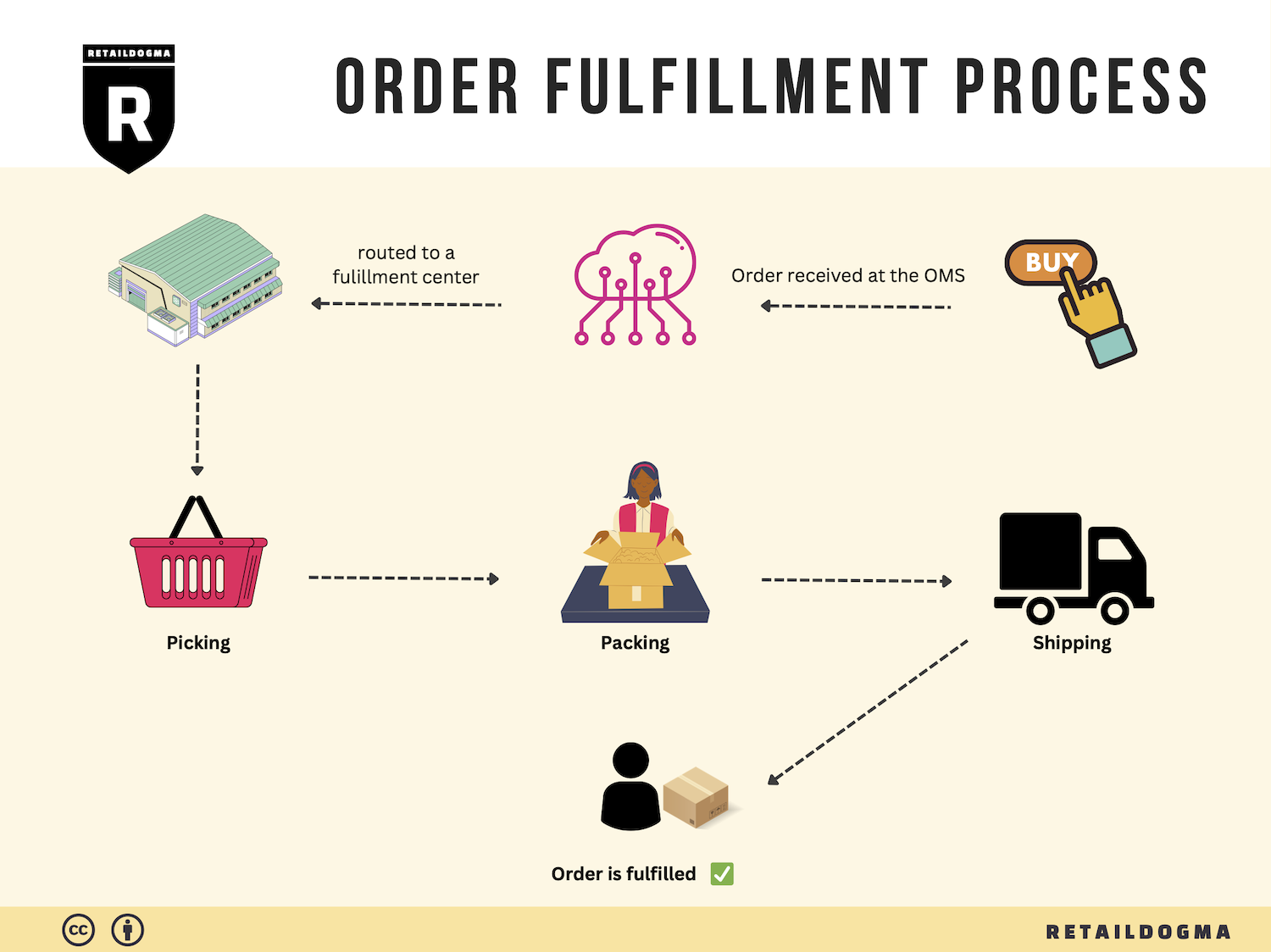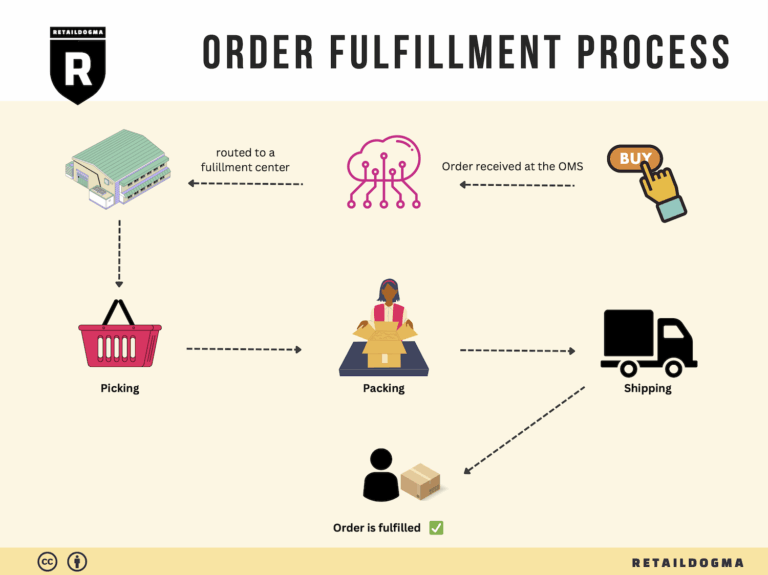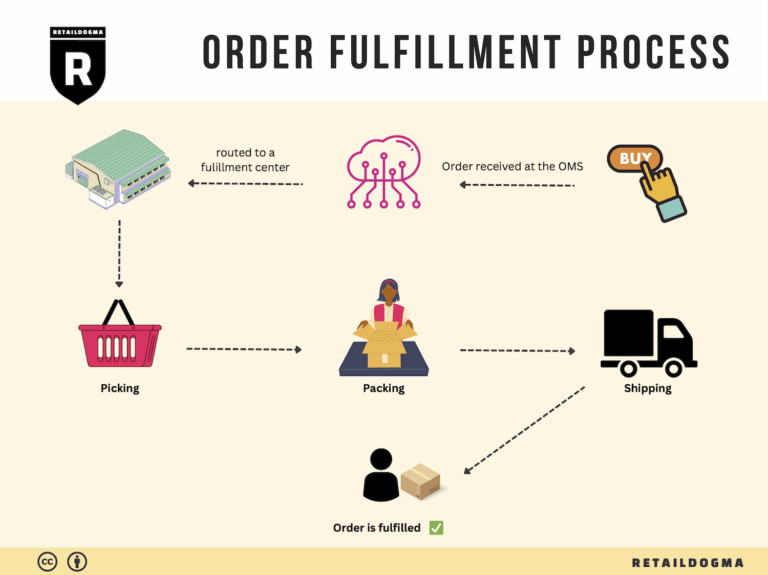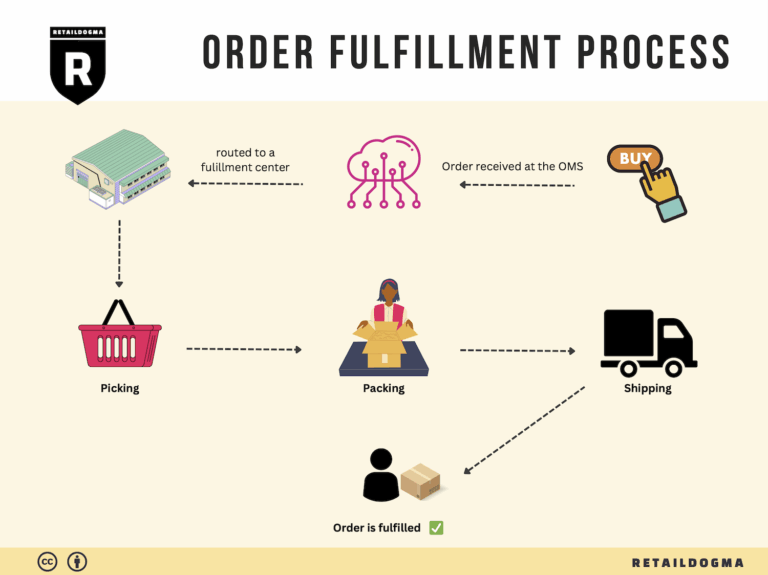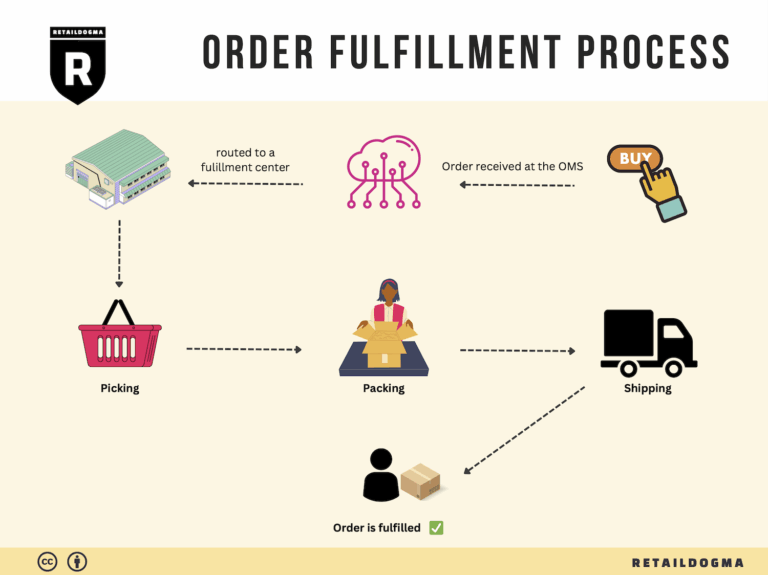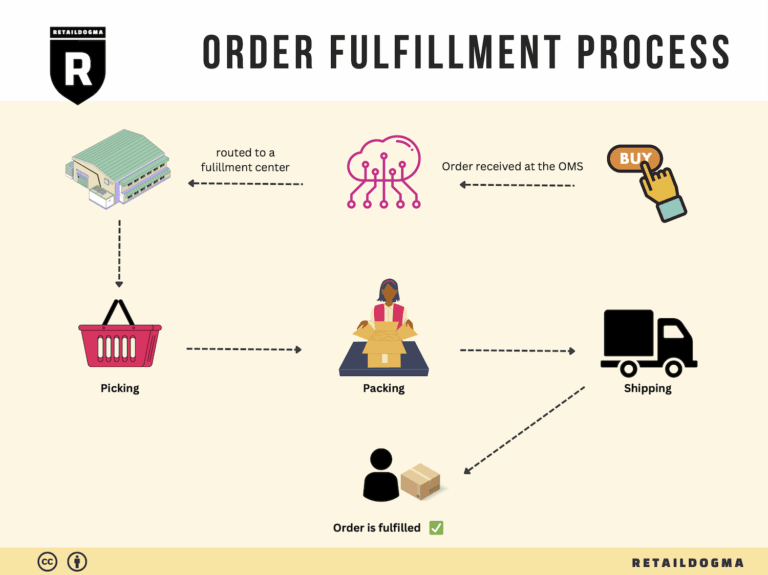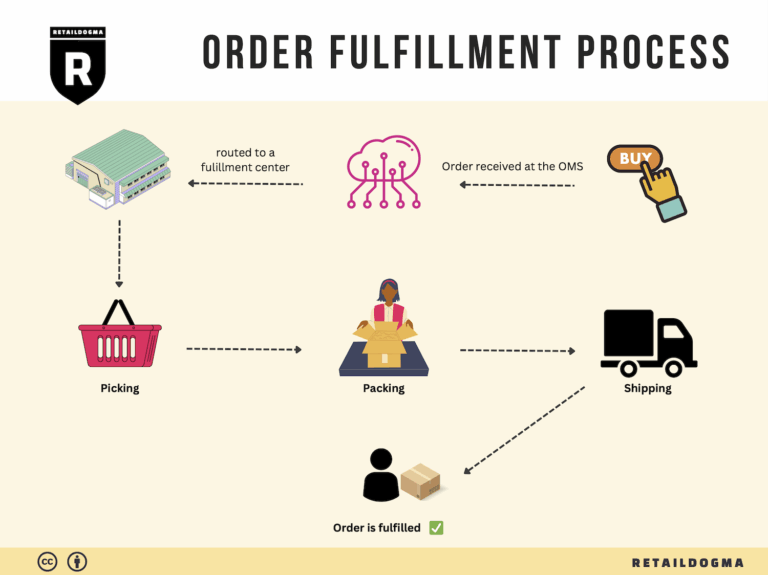What Is A Fulfillment Center? A Complete Guide (2025)
What is E-commerce Fulfillment? An Introduction for Growing Businesses
Navigating the Complex World of E-commerce Fulfillment
As an e-commerce business owner, you may find yourself overwhelmed by the sheer volume of packing and shipping orders. This crucial part of your operations can quickly become a bottleneck, consuming valuable time and resources that could otherwise be spent on scaling your business. In the fast-paced world of online retail, where customer expectations for speed and accuracy are higher than ever, understanding the fulfillment process is essential for your growth.
E-commerce fulfillment is simply the process of getting a product from your inventory to your customer’s doorstep. This encompasses a variety of activities, including receiving and storing inventory, processing orders, picking and packing items, and finally, shipping them to customers. With the right fulfillment strategy in place, you can not only enhance customer satisfaction but also streamline your operations for better efficiency and cost-effectiveness.
In this guide, we will explore several critical aspects of e-commerce fulfillment that every growing business should understand. First, we’ll delve into the different fulfillment models available, such as Third-Party Logistics (3PL) and Fulfillment by Amazon (FBA), helping you determine which option aligns best with your business needs.
Next, we’ll break down the core services involved in the fulfillment process, including inventory management, order processing, shipping logistics, and returns management. Understanding these components will empower you to optimize your fulfillment strategy and enhance customer experience.
Choosing the right fulfillment partner is another crucial element we’ll cover. We’ll provide guidance on what to look for in a fulfillment provider, from technology capabilities to customer service, ensuring that you select a partner that can support your growth ambitions.
Lastly, we’ll discuss pricing models for fulfillment services, helping you understand the costs involved and how to budget effectively for this essential aspect of your business.
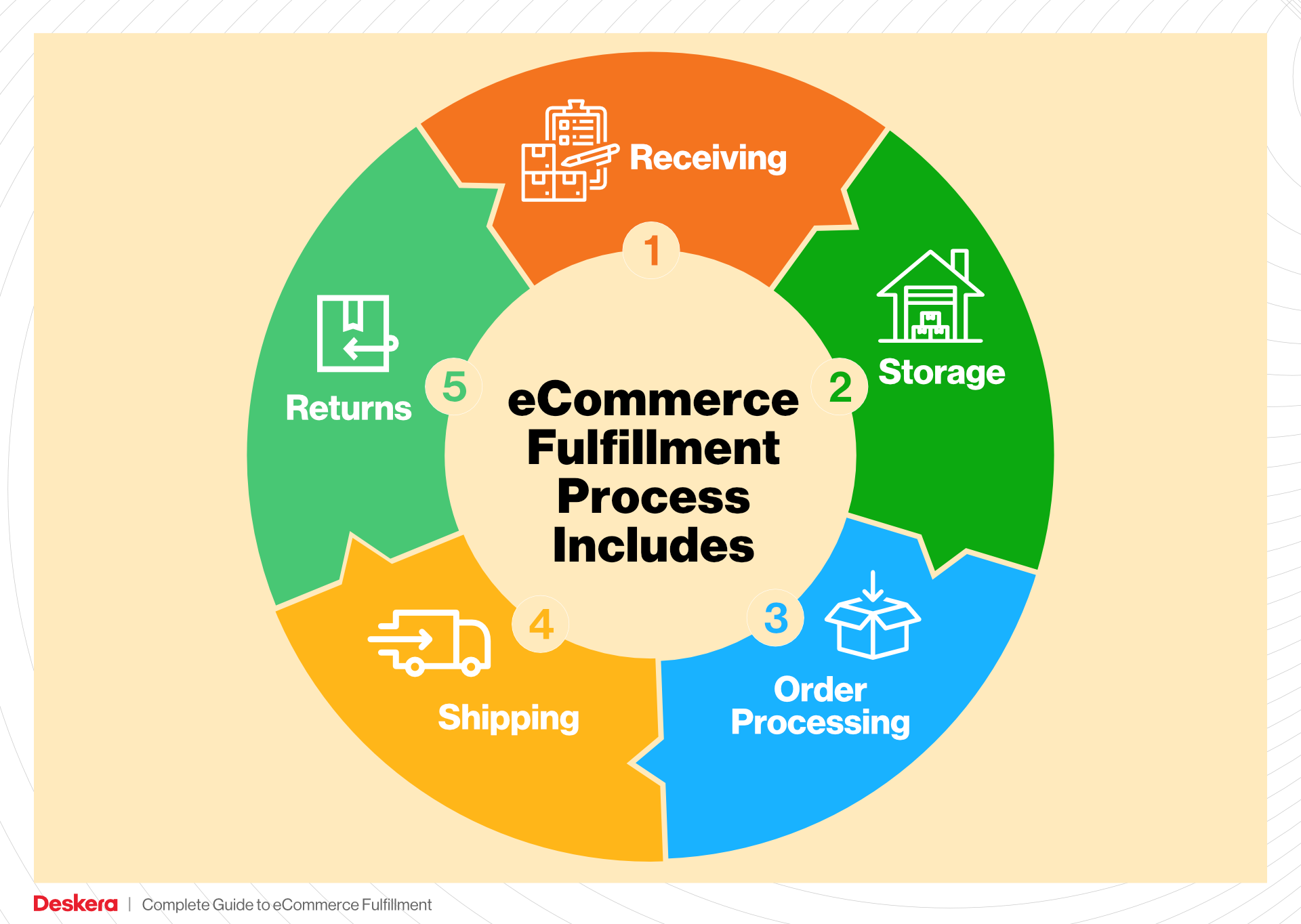
Our goal with this guide is to empower you with the knowledge and tools necessary to make informed decisions about your logistics. By mastering the complexities of e-commerce fulfillment, you can focus on what truly matters: growing your business and delighting your customers.
What You’ll Learn In This Guide
- What is E-commerce Fulfillment? An Introduction for Growing Businesses
- The Order Fulfillment Process: From ‘Buy’ Button to Customer’s Door
- Comparing Fulfillment Models: In-House vs. 3PL vs. Dropshipping
- A Deep Dive into Amazon FBA: Pros, Cons, and Who It’s For
- Core Services Offered by Fulfillment Centers
- How to Choose a Fulfillment Partner: A 6-Point Checklist
- Understanding Fulfillment Pricing: A Breakdown of Common Fees
- Frequently Asked Questions (FAQs) about Fulfillment
- Conclusion: Is Outsourcing Fulfillment the Right Move for Your Business?
- Important Disclaimer
The Order Fulfillment Process: From ‘Buy’ Button to Customer’s Door
1. Receiving Inventory
The order fulfillment process begins with receiving inventory from suppliers. This step involves checking incoming shipments against purchase orders to ensure accuracy in terms of quantity and quality. Key terms associated with this process include SKU (Stock Keeping Unit), which helps in tracking individual items.
Once the inventory is received, it is crucial to conduct a quality control check to identify any damages or discrepancies. This step is vital because receiving errors can lead to stockouts or customer dissatisfaction if incorrect or damaged products are shipped. A well-organized receiving process sets the foundation for efficient warehouse operations, ensuring that the right products are available for subsequent steps in the fulfillment process.
2. Warehouse Storage
After inventory is received and inspected, the next step is warehouse storage. This involves categorizing and storing items in designated locations within the warehouse for easy access during order fulfillment. Efficient warehouse management practices are essential at this stage, often facilitated by a Warehouse Management System (WMS) that optimizes space and enhances inventory visibility.
Proper storage is important because it affects picking speed and accuracy. Items should be stored based on their sales velocity—high-turnover items should be placed closer to the packing area to minimize travel time. Additionally, organized storage helps reduce the risk of errors and increases operational efficiency, allowing your business to scale effectively as order volumes grow.
3. Order Picking
Once an order is placed, the next step is order picking, where items are retrieved from their storage locations. This process utilizes pick lists, which detail the items and quantities needed for each order. The picking method can vary—some businesses may use single-order picking, while others may utilize batch picking to fulfill multiple orders simultaneously.
Efficient order picking is critical to maintaining fast turnaround times and meeting customer expectations for timely delivery. The accuracy of this step directly impacts customer satisfaction; errors in picking can lead to returns and increased operational costs. Implementing technology such as barcode scanning can streamline the picking process, ensuring that the correct items are selected and reducing the likelihood of mistakes.
4. Order Packing
After items have been picked, the next step is order packing. This process involves carefully placing the picked items into boxes or packaging materials, ensuring they are secured for transit. Key considerations during packing include the use of appropriate packing materials to prevent damage and the inclusion of necessary documentation, such as packing slips or invoices.
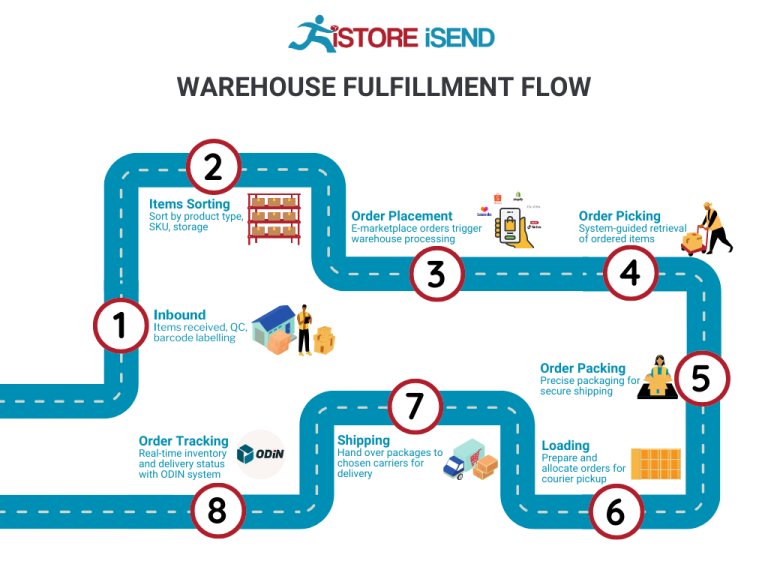
Effective packing is crucial because it protects products during shipping and enhances the unboxing experience for customers. A well-executed packing process can reduce shipping costs, as using the right-sized packaging minimizes dimensional weight charges. Moreover, incorporating branding elements in the packaging can boost customer loyalty and encourage repeat purchases.
5. Shipping & Delivery
The final step in the order fulfillment process is shipping and delivery, where packed orders are dispatched to customers. This involves selecting a shipping carrier based on factors such as cost, speed, and delivery zones. Businesses often leverage relationships with multiple carriers to optimize shipping costs and delivery times.
Shipping is a critical component of customer satisfaction, as delivery speed and accuracy are often key determinants of a customer’s overall experience. Implementing real-time tracking systems allows customers to monitor their order status, further enhancing their experience. A smooth shipping and delivery process not only fulfills the order but also builds trust and encourages repeat business, making it an essential aspect of your fulfillment strategy.
By understanding and optimizing each of these steps, e-commerce businesses can create a streamlined order fulfillment process that enhances customer satisfaction and drives growth.
Comparing Fulfillment Models: In-House vs. 3PL vs. Dropshipping
Fulfillment Model Comparison
| Model | Who Handles Inventory | Best For (Business Stage) | Key Advantage | Key Disadvantage |
|---|---|---|---|---|
| In-House Fulfillment | The business itself | Startups to Mid-Size | Complete control over inventory and processes | High overhead costs and scalability issues |
| Third-Party Logistics (3PL) | A third-party provider | Growth-Stage Companies | Cost-effective and scalable solutions | Less control over the fulfillment process |
| Dropshipping | Supplier or manufacturer | Startups and Small Businesses | Minimal upfront investment and risk | Lower profit margins and reliance on suppliers |
In-House Fulfillment
In-house fulfillment involves managing all aspects of the order fulfillment process within the business itself. This model is often adopted by startups or mid-sized companies that want to maintain complete control over their inventory, order processing, and shipping. Businesses utilizing in-house fulfillment typically store their products in a warehouse or dedicated space, handle order picking and packing, and manage shipping logistics independently. The key advantage of this approach is the direct oversight and control over the entire process, which can lead to a tailored customer experience and potentially higher quality assurance. However, this model can also present significant challenges, such as high overhead costs associated with warehousing, staffing, and equipment. Additionally, as order volumes grow, the scalability of in-house fulfillment can become a bottleneck, requiring businesses to invest in infrastructure or technology to keep up with demand.
Third-Party Logistics (3PL)
Third-party logistics (3PL) providers handle various aspects of the fulfillment process for e-commerce businesses. This model is particularly beneficial for growth-stage companies that need to scale their operations without the burden of managing logistics themselves. By outsourcing fulfillment to a 3PL, businesses can leverage the provider’s established infrastructure, expertise, and technology, allowing them to focus on core business activities like marketing and product development. The key advantage of using a 3PL is the cost-effectiveness and scalability it offers; businesses can access discounted shipping rates, advanced inventory management systems, and a network of fulfillment centers without needing to invest heavily in their own logistics infrastructure. However, one downside is the potential loss of control over the fulfillment process, which can impact customer experience if the 3PL does not meet the brand’s standards or expectations. Additionally, there may be complexities in managing relationships and ensuring seamless communication with the provider.
Dropshipping
Dropshipping is a fulfillment model where the retailer does not hold inventory but instead transfers customer orders and shipment details to a third-party supplier or manufacturer, who then ships the products directly to the customer. This model is ideal for startups and small businesses looking to minimize upfront investments and risks associated with holding inventory. The primary advantage of dropshipping is the minimal financial risk; businesses only pay for products after they have been sold, which allows for greater flexibility and lower overhead costs. Furthermore, dropshipping enables businesses to offer a wider range of products without the need for significant capital investment in inventory. However, this model also comes with notable disadvantages, including lower profit margins due to reliance on suppliers, potential issues with product quality and shipping times, and the challenge of maintaining brand consistency. Additionally, businesses may face difficulties in managing customer service and returns, as they have less control over the fulfillment process.
A Deep Dive into Amazon FBA: Pros, Cons, and Who It’s For
Understanding Fulfillment by Amazon (FBA)
Fulfillment by Amazon (FBA) is a service offered by Amazon that allows e-commerce businesses to store their products in Amazon’s fulfillment centers. When a customer orders a product, Amazon takes care of the entire fulfillment process, which includes picking, packing, shipping, and customer service. This model has become increasingly popular among sellers looking to leverage Amazon’s extensive logistics network and customer trust.
How FBA Works
-
Product Listing: Sellers create product listings on Amazon, specifying whether they want to use FBA. Once the product is listed, sellers must prepare and ship their inventory to Amazon’s fulfillment centers.
-
Inventory Management: After the inventory is received at the fulfillment center, Amazon takes care of storing it safely until an order is placed. Sellers can monitor their inventory levels through the Amazon Seller Central dashboard.
-
Order Fulfillment: When a customer places an order, Amazon handles the picking and packing of the product. They also manage shipping, ensuring that the item is dispatched quickly.
-
Customer Service: Amazon also manages customer service inquiries and returns for FBA products, streamlining the process for sellers.

-
Payment: After an order is fulfilled, sellers receive payment from Amazon, minus the applicable fees.
Pros of Amazon FBA
Prime Eligibility
One of the most significant advantages of FBA is that products become eligible for Amazon Prime. This means that Prime members can benefit from free two-day shipping, which can significantly increase sales. Many customers prefer Prime-eligible products, making it an essential feature for sellers looking to maximize their reach.
Customer Trust
Leveraging Amazon’s brand recognition can help new and established sellers alike. Customers often feel more comfortable purchasing from sellers using FBA because of the trust associated with Amazon’s handling of logistics and customer service. This can lead to higher conversion rates, as customers are more likely to complete a purchase when they see the trusted Amazon logo.
Multi-Channel Fulfillment
FBA allows sellers to fulfill orders from other sales channels, such as their own websites or other marketplaces. This multi-channel fulfillment capability enables sellers to centralize their inventory management while leveraging Amazon’s logistics network for all their sales.
Cons of Amazon FBA
High Fees
While FBA can simplify logistics, it comes at a cost. Amazon charges various fees, including storage fees for keeping inventory in their warehouses and fulfillment fees for each order processed. These fees can quickly add up, especially for businesses with tight profit margins or those selling low-priced items. Sellers must carefully calculate their costs to ensure that they remain profitable.
Strict Inventory Rules
Amazon has stringent guidelines regarding inventory management. Sellers must adhere to specific preparation and packaging requirements, and any violations can lead to additional charges or even suspension of their FBA privileges. This can create challenges for sellers, particularly those who are new to the platform and may not be familiar with these regulations.
Commingling Risks
FBA uses a commingling system, which means that products from different sellers may be stored in the same location. While this can speed up fulfillment times, it also poses risks. If a customer receives a damaged or defective product, the seller may face negative feedback, impacting their seller rating, even if the product was not theirs. This makes quality control and brand reputation management more challenging for sellers.
Who is FBA Best For?
Fulfillment by Amazon is particularly well-suited for:
-
Small to Medium-Sized Businesses: Sellers looking to scale their operations without the overhead of managing their own warehousing and fulfillment can benefit significantly from FBA. It allows them to focus on marketing and sales rather than logistics.
-
E-commerce Entrepreneurs: New entrepreneurs who want to tap into Amazon’s vast customer base and trust can find FBA to be an effective entry point into the market. The ease of use and access to Prime customers can accelerate growth.
-
Brands with High Sales Volume: Businesses that already have a steady sales volume can leverage FBA to handle increased order fulfillment without compromising on speed or customer service.
-
Multi-Channel Sellers: Companies that sell across various platforms and want a centralized logistics solution can use FBA to simplify operations and maintain efficient inventory management.
In conclusion, while Fulfillment by Amazon offers numerous advantages, such as Prime eligibility and customer trust, potential sellers must weigh these benefits against the associated costs and risks. Understanding your business model and customer expectations is crucial for determining whether FBA is the right fit for your e-commerce operation.
Core Services Offered by Fulfillment Centers
Inventory Management & Warehousing
Inventory management is the backbone of any successful e-commerce operation. Fulfillment centers offer robust inventory management services that encompass the tracking, storing, and forecasting of stock levels. This ensures that e-commerce businesses maintain optimal inventory levels to meet customer demand while minimizing excess stock that can lead to cash flow issues.
The benefits of effective inventory management include:
- Real-Time Visibility: Advanced inventory management systems provide businesses with real-time data on stock levels, allowing them to make informed decisions quickly.
- Reduced Stockouts: By maintaining the right amount of inventory, businesses can avoid stockouts, ensuring that they meet customer demand and do not miss out on sales opportunities.
- Streamlined Operations: Efficient warehousing solutions mean that products are stored in an organized manner, enabling quick retrieval and processing. This speeds up the fulfillment process and enhances customer satisfaction.
- Cost Savings: By utilizing a fulfillment center’s warehousing services, e-commerce businesses can save on overhead costs associated with owning and operating their own storage facilities.
In summary, fulfillment centers provide essential inventory management and warehousing services that facilitate smooth operations, enabling businesses to focus on growth and customer experience.
Pick and Pack Services
Pick and pack services are at the heart of the fulfillment process. This service involves the selection (picking) of ordered items from inventory and the preparation (packing) of those items for shipment. Fulfillment centers employ specialized systems and trained staff to ensure this process is efficient and accurate.
The advantages of utilizing pick and pack services include:
- Increased Accuracy: Fulfillment centers use technology like barcode scanning to minimize errors in picking, ensuring that customers receive the correct items.
- Scalability: As e-commerce businesses grow, their order volumes can fluctuate significantly. Fulfillment centers can easily scale their pick and pack operations to meet increasing demand without requiring the business to invest in additional resources.
- Faster Turnaround Times: With dedicated staff and optimized processes, fulfillment centers can significantly reduce the time it takes to process and ship orders, aligning with customer expectations for quick delivery.
- Custom Packaging Options: Many fulfillment providers offer customizable packing solutions that can enhance branding and improve the unboxing experience for customers.
By leveraging pick and pack services, e-commerce businesses can ensure that orders are fulfilled quickly and accurately, leading to higher customer satisfaction and repeat business.
Kitting and Assembly
Kitting and assembly services involve bundling individual items together to create a single product offering. This could include assembling products that require multiple components or creating gift sets with various items packaged together. Fulfillment centers can handle this complex process efficiently, allowing businesses to offer unique product configurations without the associated logistical headaches.
The benefits of kitting and assembly services include:
- Enhanced Product Offerings: By providing custom kits or bundled products, businesses can differentiate themselves in the market and attract more customers.
- Efficiency in Production: Outsourcing kitting to a fulfillment center allows businesses to streamline their production processes, freeing up internal resources for other strategic initiatives.
- Cost-Effective Solutions: Fulfillment centers often have the resources and expertise to perform kitting and assembly more cost-effectively than an e-commerce business could in-house.
- Quality Control: Professional fulfillment centers implement quality control measures during the kitting process, ensuring that products are assembled correctly and meet customer expectations.
Utilizing kitting and assembly services enables e-commerce businesses to enhance their product offerings while ensuring operational efficiency and quality.
Returns Management (Reverse Logistics)
Returns management, often referred to as reverse logistics, is a critical service offered by fulfillment centers. This process includes handling the return of products from customers, assessing their condition, restocking them if possible, and managing refunds or exchanges. Given the rise of e-commerce, an efficient returns process is essential for maintaining customer satisfaction and brand loyalty.
The advantages of a well-managed returns process include:
- Customer Satisfaction: An easy and efficient return process enhances the customer experience, encouraging repeat purchases and positive reviews.
- Cost Reduction: Fulfillment centers can process returns quickly, minimizing the time products spend in reverse logistics and helping businesses recover value from returned items.
- Data Insights: Returns management provides valuable data on customer preferences and product performance. This information can inform inventory decisions and help businesses improve product offerings.
- Operational Efficiency: By outsourcing returns management to a fulfillment center, businesses can streamline their operations, allowing them to focus on growth and customer engagement.
In conclusion, effective returns management is vital for e-commerce success. By partnering with fulfillment centers that specialize in reverse logistics, businesses can enhance customer satisfaction and operational efficiency, ultimately driving growth.
How to Choose a Fulfillment Partner: A 6-Point Checklist
Location & Warehouse Network
Importance:
The geographical location of your fulfillment partner’s warehouses plays a critical role in determining shipping speeds and costs. A well-distributed warehouse network can help you reach customers quickly and efficiently, especially if you cater to a nationwide or global audience.
Questions to Ask:
– Where are your fulfillment centers located, and how do they align with my primary customer demographics?
– What are your shipping times to key regions, and can you offer expedited shipping options?
– Do you have a plan for expanding your network as my business grows?
Technology & Integrations
Importance:
In today’s digital age, the technology used by your fulfillment partner can significantly impact your operational efficiency. A robust fulfillment system should seamlessly integrate with your e-commerce platform, inventory management system, and any other tools you rely on.
Questions to Ask:
– What technology platforms do you use for order management, inventory tracking, and shipping?
– Can your systems integrate with my current e-commerce and inventory management platforms?
– Do you provide real-time tracking capabilities for both my team and my customers?
Specializations (e.g., cold storage, oversized items)
Importance:
Different products have different storage and handling requirements. If your business involves specialized items, such as perishable goods or oversized products, choosing a partner with relevant expertise is crucial to avoid potential mishaps and ensure compliance with regulations.
Questions to Ask:
– Do you have experience handling my specific type of products (e.g., perishables, heavy items, hazardous materials)?
– What facilities do you have for special storage needs, such as cold storage or climate control?
– Can you accommodate custom packaging or kitting requirements for my products?
Scalability & Capacity
Importance:
As your business grows, your fulfillment needs will evolve. A partner that can scale with you will save you the hassle of switching providers mid-growth phase, which can be disruptive and costly.
Questions to Ask:
– What is your current capacity, and how do you handle peak seasons or unexpected demand surges?
– Can you provide a roadmap for how you would scale operations in line with my business growth?
– How do you manage inventory levels to avoid stockouts or overstock situations?
Pricing and Contracts
Importance:
Understanding the pricing structure is essential for maintaining profitability. Transparent pricing helps you avoid unexpected costs and allows you to plan your budget effectively.
Questions to Ask:
– What are your pricing models (e.g., per order, monthly fees, storage fees), and what does each include?
– Are there any hidden fees, such as for returns or additional services?
– What are the terms of the contract, and do you offer flexible options that allow for adjustments based on my business needs?
Customer Support & Reviews
Importance:
Reliable customer support can be a game changer when issues arise. Additionally, researching reviews and testimonials can provide insights into the partner’s reliability and service quality.
Questions to Ask:
– What customer support channels do you offer (e.g., phone, email, chat), and what are your response times?
– Can you provide references or case studies from businesses similar to mine?
– How do you handle fulfillment issues or customer complaints, and what is your protocol for resolving them?
Conclusion
Choosing the right fulfillment partner is crucial for e-commerce success. This checklist serves as a guide to help you evaluate potential partners comprehensively. By carefully considering each of these factors and asking the right questions, you can make an informed decision that aligns with your business goals and enhances your operational efficiency. A strong partnership in fulfillment not only supports your logistics needs but also contributes to overall customer satisfaction, driving repeat business and long-term growth.
Understanding Fulfillment Pricing: A Breakdown of Common Fees
Initial Setup Fees
When partnering with a fulfillment provider, businesses often encounter initial setup fees. These charges cover the costs associated with onboarding your business into the provider’s system. The setup process typically includes creating an account, integrating your e-commerce platform with their system, and customizing your fulfillment processes to align with your specific needs.
Initial setup fees can vary significantly based on the complexity of your requirements and the fulfillment provider’s offerings. Some providers may charge a flat fee, while others might calculate costs based on the number of products or SKUs being integrated. Expect to pay anywhere from a few hundred to several thousand dollars, depending on the scale of your operation. To minimize these costs, consider discussing your needs in detail with the provider and negotiating any unnecessary features or services that may inflate the setup fee.
Receiving Fees
Receiving fees are charged when your inventory arrives at the fulfillment center. These fees cover the labor and resources required to unload, inspect, and store your products. The calculation of receiving fees can be straightforward or complex, depending on the provider’s policies.
Typically, receiving fees are charged per pallet or per item, with costs ranging from $10 to $50 per pallet, or a similar amount per item. Factors influencing this fee include the size and weight of the items, as well as the complexity involved in the receiving process. To control these costs, ensure that your shipments are organized and well-documented, reducing the time and effort needed for the fulfillment center to process them.
Storage Fees (per pallet/bin)
Storage fees are incurred for the space your inventory occupies within the fulfillment center. These fees are usually calculated on a monthly basis and can be charged per pallet, per bin, or per cubic foot, depending on the provider’s pricing structure.
Storage fees typically range from $15 to $30 per pallet per month. Some providers may offer tiered pricing based on the volume of inventory stored, rewarding businesses with larger inventories with lower rates. To optimize storage costs, consider implementing efficient inventory management practices, such as conducting regular stock audits to minimize overstock and avoid long-term storage fees.
Pick & Pack Fees (per item/order)
Pick and pack fees are associated with the process of selecting items from inventory and preparing them for shipment. This fee is usually charged per item or per order and covers the labor involved in picking, packing, and labeling products for delivery.
Pick and pack fees generally range from $0.50 to $3.00 per item, or $1.00 to $5.00 per order, depending on the complexity of the packing process. Factors influencing this fee include the number of items in an order, the type of packaging required, and any special handling instructions. To reduce these fees, streamline your order fulfillment processes by optimizing your product catalog to reduce the number of unique SKUs and simplifying packaging requirements.
Shipping Fees
Shipping fees encompass the costs associated with transporting orders to customers. These fees can vary widely based on factors such as shipping distance, carrier choice, delivery speed, and package dimensions. Most fulfillment providers negotiate bulk shipping rates with carriers, which can lead to lower shipping costs for your business.
Shipping fees can be calculated based on weight, dimensions, and delivery zones, and can range from $5 to $20 or more per package. To get the best rates, work closely with your fulfillment provider to understand their shipping partnerships and take advantage of any discounts available. Additionally, consider offering multiple shipping options to customers, allowing them to choose between expedited services and more economical choices.
Tips for Getting an Accurate Quote
-
Provide Detailed Information: When requesting a quote, offer comprehensive details about your business, including the types of products you sell, order volumes, and expected shipping destinations. This information allows providers to give you a more tailored and accurate estimate.
-
Ask About All Fees: Ensure you understand all potential fees associated with the fulfillment process, including any hidden charges. Request a breakdown of costs to avoid surprises later on.
-
Negotiate Terms: Many fulfillment providers are open to negotiation, especially if you can demonstrate potential for high order volumes. Don’t hesitate to discuss pricing structures and seek better terms.
-
Evaluate Multiple Providers: Get quotes from multiple fulfillment providers to compare pricing and services. This will give you a clearer picture of the market and help you identify the best fit for your business.
-
Consider Future Growth: When evaluating quotes, consider not only your current needs but also your projected growth. Choose a provider that can scale with your business to avoid having to switch fulfillment partners later.
By understanding these common fulfillment pricing models and following these tips, e-commerce businesses can make informed decisions that align with their operational needs and budget constraints.
Frequently Asked Questions (FAQs) about Fulfillment
1. What is ecommerce fulfillment?
Ecommerce fulfillment encompasses the entire process of receiving, processing, and delivering customer orders made online. This includes inventory management, order processing, picking and packing items, and shipping products to customers. A seamless fulfillment process is crucial for meeting customer expectations regarding speed, accuracy, and cost.
2. What is the difference between a warehouse and a fulfillment center?
A warehouse primarily serves as a storage facility for goods, where products are kept until needed. In contrast, a fulfillment center is a specialized type of warehouse designed for the entire order fulfillment process, including inventory management, order processing, packing, and shipping. Fulfillment centers are optimized for speed and efficiency to meet customer demand.
3. What is a 3PL (Third-Party Logistics)?
A Third-Party Logistics (3PL) provider is a company that offers outsourced logistics services, including warehousing, fulfillment, and shipping. Businesses partner with 3PLs to leverage their expertise, infrastructure, and technology, allowing them to scale operations, reduce costs, and improve service delivery.
4. How much do fulfillment services cost?
Fulfillment service costs vary based on several factors, including order volume, storage space, shipping methods, and additional services (like kitting or returns management). On average, fulfillment costs can range from $1 to $5 per order, plus storage fees that can be charged monthly or based on inventory volume. It’s advisable to request quotes from multiple providers to compare pricing structures.
5. How does inventory management work in fulfillment?
Inventory management involves tracking and controlling the stock of products available for sale. In fulfillment, this includes monitoring inventory levels, forecasting demand, reordering products, and ensuring that stock is available to meet customer orders. Effective inventory management helps prevent stockouts and overstock situations, optimizing cash flow and customer satisfaction.
6. What are the key components of the order fulfillment process?
The key components of the order fulfillment process include:
– Receiving inventory: Accepting and storing products in a warehouse.
– Order processing: Managing incoming orders from various sales channels.
– Picking: Selecting the correct items from inventory.
– Packing: Preparing items for shipment, ensuring they are secure.
– Shipping: Dispatching orders to customers via chosen carriers.
– Returns management: Handling returned items and reintegrating them into inventory.
7. What shipping options should I consider for my ecommerce business?
Consider offering a variety of shipping options based on your target market and product type, including:
– Standard shipping
– Expedited shipping (2-day delivery)
– Free shipping over a certain order value
– International shipping
– Same-day or next-day delivery (if feasible)
Offering multiple options can enhance customer satisfaction and increase conversion rates.
8. How can I ensure fast shipping for my customers?
To ensure fast shipping, consider the following strategies:
– Partner with a reliable fulfillment provider that has a network of fulfillment centers close to your customer base.
– Utilize technology for real-time inventory management and order processing.
– Implement efficient packing and shipping processes to minimize delays.
– Offer multiple shipping options, including expedited services, to meet customer expectations.
9. What is returns management, and why is it important?
Returns management, also known as reverse logistics, involves the process of handling returned products from customers. This includes receiving returns, assessing their condition, restocking items, and processing refunds or exchanges. Effective returns management is crucial because it enhances customer satisfaction, reduces operational costs, and helps maintain accurate inventory levels.
10. How can I scale my fulfillment operations as my business grows?
To scale your fulfillment operations effectively:
– Consider outsourcing to a 3PL provider to leverage their expertise and infrastructure.
– Invest in inventory management software to optimize stock levels and order processing.
– Regularly review and refine your fulfillment processes to identify areas for improvement.
– Monitor key performance indicators (KPIs) to ensure your fulfillment strategy aligns with business growth.
Conclusion: Is Outsourcing Fulfillment the Right Move for Your Business?
Evaluating the Benefits of Outsourcing Fulfillment
In today’s competitive e-commerce landscape, the efficiency of your fulfillment process can directly impact customer satisfaction and business growth. By outsourcing fulfillment, businesses can unlock several key advantages that streamline operations and enhance customer experiences.
First and foremost, partnering with a fulfillment provider saves invaluable time. Managing inventory, processing orders, and handling shipping logistics can be overwhelming, particularly for growing businesses. Outsourcing these responsibilities allows you to focus on core activities such as marketing, product development, and customer engagement, ultimately driving sales and fostering growth.
Scalability is another critical benefit of outsourcing fulfillment. As your business expands, demand can fluctuate significantly. A reliable fulfillment partner can swiftly adapt to these changes, ensuring you have the capacity to handle increased order volumes without compromising service quality. This flexibility is essential for maintaining high customer satisfaction, especially during peak seasons.
Moreover, fulfillment providers bring specialized expertise to the table. They are equipped with advanced technology, established shipping networks, and proven processes that can enhance efficiency and accuracy. This expertise not only reduces shipping times but can also lead to cost savings through bulk shipping discounts that are often unavailable to individual businesses.
However, it is crucial to choose the right fulfillment partner to align with your business goals. The ideal provider should understand your unique needs and offer solutions that support your growth trajectory.
Call to Action
To determine if outsourcing fulfillment is the right move for your business, conduct a thorough audit of your current shipping and fulfillment processes. Assess your operational bottlenecks, shipping costs, and customer feedback to identify areas for improvement. Exploring the option of a fulfillment partner could be the strategic step needed to elevate your business to the next level.
Important Disclaimer
⚠️ Important Disclaimer
The information in this guide is for educational purposes. Fulfillment services, pricing, and platform features change frequently. Always conduct your own due diligence and consult with providers directly before making business decisions.
